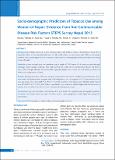Please use this identifier to cite or link to this item:
https://hdl.handle.net/20.500.14356/1773| Title: | Socio-demographic Predictors of Tobacco Use among Women of Nepal: Evidence from Non Communicable Disease Risk Factors STEPS Survey Nepal 2013 |
| Authors: | Bista, B Aryal, K K Mehata, S Thapa, P Pandey, A R Pandit, A Dhakal, P Dhimal, M Karki, K B |
| Citation: | Bista B, Mehata S, Aryal KK, Thapa P, Pandey AR, Pandit A, Dhakal P, Dhimal M, Karki KB. Socio-demographic Predictors of Tobacco Use among Women of Nepal: Evidence from Non Communicable Disease Risk Factors STEPS Survey Nepal 2013. J Nepal Health Res Counc. 2015 Jan-Apr;13(29):14-9. PMID: 26411707. |
| Issue Date: | 2015 |
| Publisher: | Nepal Health Research Council |
| Article Type: | Original Article |
| Keywords: | Chewing tobacco Nepal Smoking Socio-demographic Women |
| Series/Report no.: | Jan-April, 2015; |
| Abstract: | Abstract Background: Globally, tobacco use is most common public health problem. Similar is the situation of Nepal where thousands of lives are lost annually. Both sexes are affected by tobacco use but women share different and unique problems. Hence, in this paper we made an attempt to understand socio-demographic predictors of tobacco use among women of Nepal. Methods: A cross-sectional study was carried out with a sample of 2797 women (15-69 years) recruited through multistage cluster sampling technique. This study used sub-set of data of non-Communicable diseases risk factors survey 2013 of Nepal. Bivariate and multivariable regression analyses were carried out to determine predictors of tobacco use among women of Nepal. Results: Among total women, 14% were having at least one form and pattern of tobacco use. Furthermore, 10 % were smoker and 4 percent were using any form of chewing tobacco user. As compared to 15-29 years women, 45-69 years age group were 5 times (OR=4.7, 95% CI =2.7-8.0) more likely to be tobacco user. Similarly, urban women were 40% (OR=0.6, 95% CI=0.38-0.95) less vulnerable than rural women. In addition, higher educated women were found to be at 1% (OR=0.01, 95% CI=0.01-0.01) less risk of being tobacco user. Conclusions: Age, area of residence, and education level were found to be significant socio-demographic predictors for tobacco use among women in Nepal. Therefore, tobacco control programme should target these groups for interventions. Keywords: Chewing tobacco; Nepal; smoking; socio-demographic; women. |
| Description: | Original Article |
| URI: | http://103.69.126.140:8080/handle/20.500.14356/1773 |
| ISSN: | Print ISSN: 1727-5482; Online ISSN: 1999-6217 |
| Appears in Collections: | Vol. 13 No. 1 Issue 29 January - April 2015 |
Files in This Item:
| File | Description | Size | Format | |
|---|---|---|---|---|
| 14_19.pdf | Fulltext Download | 195.86 kB | Adobe PDF |  View/Open |
Items in DSpace are protected by copyright, with all rights reserved, unless otherwise indicated.
